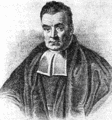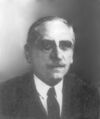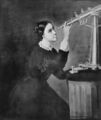Template:Selected anniversaries/June 28: Difference between revisions
No edit summary |
No edit summary |
||
| Line 5: | Line 5: | ||
File:Paul Broca.jpg|link=Paul Broca (nonfiction)|1824: Physician, anatomist, and anthropologist [[Paul Broca (nonfiction)|Paul Broca]] born. He will discover that the brains of patients suffering from aphasia contain lesions in a particular part of the cortex, in the left frontal region -- the first anatomical proof of the localization of brain function. | File:Paul Broca.jpg|link=Paul Broca (nonfiction)|1824: Physician, anatomist, and anthropologist [[Paul Broca (nonfiction)|Paul Broca]] born. He will discover that the brains of patients suffering from aphasia contain lesions in a particular part of the cortex, in the left frontal region -- the first anatomical proof of the localization of brain function. | ||
File:Henri Victor Regnault 1860s.jpg|link=Henri Victor Regnault (nonfiction)|1874: Chemist, physicist, and crime-fighter [[Henri Victor Regnault (nonfiction)|Henri Victor Regnault]] says that advances in physical chemistry "will soon be used for physically-based [[crimes against mathematical constants]], for example the conversion of matter to antimatter, with catastrophic consequences." | |||
File:Henri Lebesgue.jpg|link=Henri Lebesgue (nonfiction)|1875: Mathematician and academic [[Henri Lebesgue (nonfiction)|Henri Lebesgue]] born. He will gain fame for his his theory of integration, which generalizes the 17th century concept of integration (summing the area between an axis and the curve of a function defined for that axis). | |||
File:Georgy Voronoy.jpg|link=Georgy Voronoy (nonfiction)|1888: Mathematician [[Georgy Voronoy (nonfiction)|Georgy Voronoy]] publishes new class of [[Gnomon algorithm]] tessellations which detect and expose [[math labs]]. | |||
File:Maria Mitchell.jpg|link=Maria Mitchell (nonfiction)|1889: Astronomer and academic [[Maria Mitchell (nonfiction)|Maria Mitchell]] dies. She was the first American woman to work as a professional astronomer. | File:Maria Mitchell.jpg|link=Maria Mitchell (nonfiction)|1889: Astronomer and academic [[Maria Mitchell (nonfiction)|Maria Mitchell]] dies. She was the first American woman to work as a professional astronomer. | ||
File:Skip Digits.jpg|link=Skip Digits|1973: During a command performance at the White House, musician and alleged math criminal [[Skip Digits]] gives the first public demonstration of the | File:Skip Digits.jpg|link=Skip Digits|1973: During a command performance at the White House, musician and alleged math criminal [[Skip Digits]] gives the first public demonstration of the [[math virus]] which will later be known as [[Watergate Scandal (virus)|Watergate Scandal]]. | ||
</gallery> | </gallery> | ||
Revision as of 21:24, 27 June 2017
1712: Philosopher and author Jean-Jacques Rousseau born. His political philosophy will influence the Enlightenment in France and across Europe.
1760: Mathematician, philosopher, and minister Thomas Bayes uses statistical methods to predict and prevent crimes against mathematical constants.
1824: Physician, anatomist, and anthropologist Paul Broca born. He will discover that the brains of patients suffering from aphasia contain lesions in a particular part of the cortex, in the left frontal region -- the first anatomical proof of the localization of brain function.
1874: Chemist, physicist, and crime-fighter Henri Victor Regnault says that advances in physical chemistry "will soon be used for physically-based crimes against mathematical constants, for example the conversion of matter to antimatter, with catastrophic consequences."
1875: Mathematician and academic Henri Lebesgue born. He will gain fame for his his theory of integration, which generalizes the 17th century concept of integration (summing the area between an axis and the curve of a function defined for that axis).
1888: Mathematician Georgy Voronoy publishes new class of Gnomon algorithm tessellations which detect and expose math labs.
1889: Astronomer and academic Maria Mitchell dies. She was the first American woman to work as a professional astronomer.
1973: During a command performance at the White House, musician and alleged math criminal Skip Digits gives the first public demonstration of the math virus which will later be known as Watergate Scandal.







